Travel Through Bolivia on a Harley-Davidson
By Peter & Kay Forwood
Bolivia on a Harley (18/11/02 - 30/11/02)
Distance 1185 km (313964 km to 315149 km)
This is part of the ninth section of our around the
world trip.
Complete Trip Overview & Map
Coming from Chile
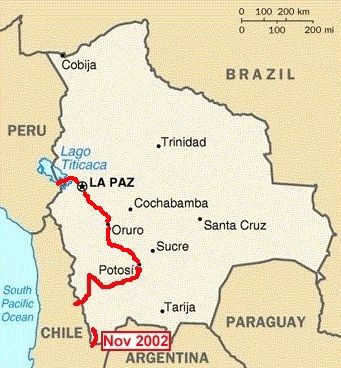 18/11/02 The road instantly changed from formed to a track
between border posts across an old coral seabed now raised to about 3700m,
hard packed but bumpy. The border officials at the rail head of Avaroa fast
and efficient. It being train day there was hot local food of llama, pasta,
rice and potatoes which we enjoyed sitting in one of the derelict train carriages.
The one track road slowly multiplied into many as it entered a salar (salt
lake). We kept to the most worn route keeping the train line in sight to
Chiguana. This salar was only just dry and there was much evidence of trucks
being bogged breaking through the salt layer churning up the mud underneath.
We headed on to San Juan, about 70 km from the border and well to the left
of the railway line. Here we managed to buy petrol from a tour operator but
it is also available in drums from other places in town. Stayed tonight in
a comfortable hostal, DBB, for $US 3.50 each.
18/11/02 The road instantly changed from formed to a track
between border posts across an old coral seabed now raised to about 3700m,
hard packed but bumpy. The border officials at the rail head of Avaroa fast
and efficient. It being train day there was hot local food of llama, pasta,
rice and potatoes which we enjoyed sitting in one of the derelict train carriages.
The one track road slowly multiplied into many as it entered a salar (salt
lake). We kept to the most worn route keeping the train line in sight to
Chiguana. This salar was only just dry and there was much evidence of trucks
being bogged breaking through the salt layer churning up the mud underneath.
We headed on to San Juan, about 70 km from the border and well to the left
of the railway line. Here we managed to buy petrol from a tour operator but
it is also available in drums from other places in town. Stayed tonight in
a comfortable hostal, DBB, for $US 3.50 each.
19/11/02 San Juan is going through a transition from traditional
village to a tourist village. We watched the llama being released from their
coral stone enclosures at dawn, women dressed in volumous petticoats with
bowler hats and black braided hair winnow last season's millet crop on hillocks
in the evening breeze and boys strut around town in their Nike shirts and
shoes. The road to the salt flats heads north through town for about 15 km
to the edge of an old coral reef then keeping the flatlands to the right
and hills to the left we turned left around the old coral reef following
a well worn corrugated and sandy track for another 35 km to the Uyuni road,
built up across the salt flats, to the right. Along this road for only a
couple of km's before we headed left across the salar heading for the volcano
far in the distance. We passed areas where men bicycled to the middle of
the salar to collect salt. Chipping away at the hard surface with picks.
After about 10 km's a small black blob appeared on the salt and slowly developed
the shape of a "Canadian Mounties hat" floating on the salar. As we got closer
all the tracks seemed to merge and we arrived at the Isla de Pescadores (Incahuasi)
in the middle of the salar surrounded by at least 30 km of salt flats in
all directions, a total of 90 km from San Juan. This cactus covered island has basic accommodation and solitude before or
after the masses of tour groups who descend here daily. We siesta'd during
their visit and headed off to the volcano, 40 km to the north, across the
salt flats in the evening. Here villagers eek out a living on the rock strewn
slopes grazing llama where the earth meets the salar, growing broad beans
and millet in the poor soils. We returned to the islet to watch the sun set
over the salt flats.
This cactus covered island has basic accommodation and solitude before or
after the masses of tour groups who descend here daily. We siesta'd during
their visit and headed off to the volcano, 40 km to the north, across the
salt flats in the evening. Here villagers eek out a living on the rock strewn
slopes grazing llama where the earth meets the salar, growing broad beans
and millet in the poor soils. We returned to the islet to watch the sun set
over the salt flats.
20/11/02 Riding on the salar yesterday was such fun that
this morning we couldn't just leave. We had awoken before dawn to see the
full moon setting from our window and walked to the top of the island to see
the sun rising. With 360 degree views of the salar, in a pink morning light,
in total solitude, a great experience. Fresh deep fried bread for breakfast
and still not wanting to leave we headed west to see just another salar islet
and to ride a little further on the salt flats. It's like riding in an ocean,
being able to go in any direction, not needing to worry about traffic, seemingly
floating across the salt.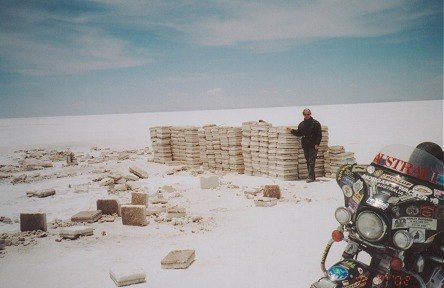 It was finally time to leave and we headed east following the well worn tracks
60 km to the salt hotel. Made entirely from salt blocks, the wall, floor,
tables, beds and chairs hard as rock, salt. A great place for a coffee but
at $US 20.00 a bed we moved on to the salt mining town of Colchani, 15 km's
and a dirt road to Uyuni a further 20 km's. The bikes, covered in salt crystals,
were pressure cleaned, the clothes filthy from dust and salt, washed, and
we rested watching this end of the tourist migration organize their tours.
It was finally time to leave and we headed east following the well worn tracks
60 km to the salt hotel. Made entirely from salt blocks, the wall, floor,
tables, beds and chairs hard as rock, salt. A great place for a coffee but
at $US 20.00 a bed we moved on to the salt mining town of Colchani, 15 km's
and a dirt road to Uyuni a further 20 km's. The bikes, covered in salt crystals,
were pressure cleaned, the clothes filthy from dust and salt, washed, and
we rested watching this end of the tourist migration organize their tours.
21/11/02 We had dropped the bike a couple of times over
the last few days in the sand (normal) and needed to straighten and weld the
crash bars stronger, this morning's job. A couple of bolts tightened, the
air cleaner cleaned, brakes greased and other minor maintenance. The welding,
drilling and strengthening of the crash bars a minor job compared to the
repairs necessary for the fleet of Toyota 4x4's ferrying tourists through
the region. At the end of each 4 day round trip the salt is pressure washed
away, the chassis sprayed with diesel to stop rust, greased, maintenance and
readied for the next attack of the corrugated roads. The main street was
closed today, market day, street stalls filled the area, street foods filled
the people. A cold change had come through in the morning and light rain
followed.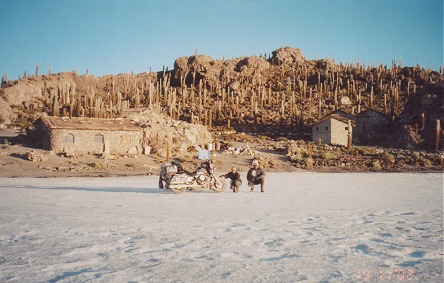
22/11/02 Ben had been travelling with us now for almost
two weeks, learning from each other's experiences, laughing at jokes and swapping
travelling stories, as we explored this remote yet tourist inundated region
of the altiplano together. Ben needs to move faster than us so is heading
directly to La Paz while we hopefully will beat the onset of the rainy season
deciding to go to Potosi. The 210 km dirt road winding up and down over mountain
passes and across open plateau country was generally formed, hard packed
but stony. Most of the river crossings are now bridged but a couple had spring
fed water flowing. This road could be a bit tricky after rain. Again great
mountain scenery with small villages wherever spring water could be diverted
to irrigate stony fields. At one stage we dropped to ride through a gorge
in a light hail and rain storm. There was the occasional mining village and
the now regular donkey or llama grazing on sparse vegetation.
23/11/02 The last two weeks have been spent at over 3000
metres above sea level in dry air and strong sunlight. Sunburn was a real
problem and dry parched skin and a dusty runny nose affects most outsiders
to the region. Potosi is billed as the world's highest city at 4070m but with
regular evening rain, at the moment, humidity is higher than where we have
recently been. This amazing place was once the biggest city in South America,
its lavish buildings financed by the world's richest silver mines, where
it is believed over 8 million people have died extracting the metal since
it was discovered here in 1545. The tourist tour took us to the local markets
to buy a supply of coca leaves as gifts to the miners. They work in the mines
all day using only the coca to keep going in the harsh conditions. After
a brief overlook from the mountain top and a demonstration dynamite explosion
we entered the narrow low tunnels of the mine.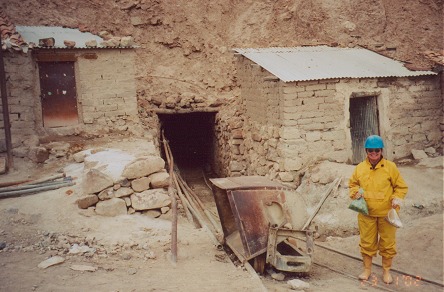 Here we encountered miners chipping away at the silver seam, sitting in the
dust and mud using only hand tools and slowly killing themselves with the
pollutants and chemicals of the mine. The lucky ones get out and work as
tour guides. The unlucky ones encourage their children to work the mine to
support them as silicosis sets into their lungs. We had purchased some dynamite
as a gift to waiting miners who had chipped a hole ready. We watched as the
dynamite was prepared, a few words to the gods El Tio or Pachamama, and after
moving to a safe area the explosion shuddered us and the surrounding earth.
The miners earn more than twice as much as similar labourers in town, encouraging
more to work the mines. The town came alive this Saturday night with street
buskers, food sellers and partyers. The large young population seem well
educated and poverty not apparent as the mine brings wealth still to the
region.
Here we encountered miners chipping away at the silver seam, sitting in the
dust and mud using only hand tools and slowly killing themselves with the
pollutants and chemicals of the mine. The lucky ones get out and work as
tour guides. The unlucky ones encourage their children to work the mine to
support them as silicosis sets into their lungs. We had purchased some dynamite
as a gift to waiting miners who had chipped a hole ready. We watched as the
dynamite was prepared, a few words to the gods El Tio or Pachamama, and after
moving to a safe area the explosion shuddered us and the surrounding earth.
The miners earn more than twice as much as similar labourers in town, encouraging
more to work the mines. The town came alive this Saturday night with street
buskers, food sellers and partyers. The large young population seem well
educated and poverty not apparent as the mine brings wealth still to the
region.
24/11/02 A morning tour of the old mint museum which had
been printing coins in silver from the mine for over 300 years. Ironically
Bolivia's coins are now minted in Spain. We headed out of town about midday
towards Oruro. The first 25 km's of asphalt followed by 120 km of development
dirt road and the remainder new asphalt. It started raining almost as soon
as we left and continued almost the entire dirt section with occasional hail
and cold winds. Through the mountains bulldozers were cutting a new road
through clay soils and trucks were bogged in the mud. Locals were out in
the rain with dry sand trying to free them from the clay. Luckily the worst
two sections were downhill for us and with Kay walking we slid through.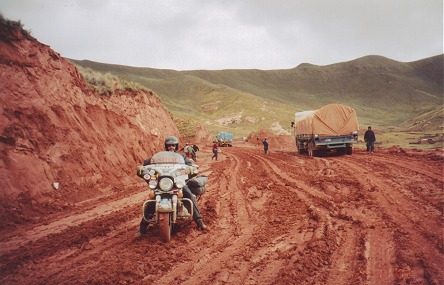 Five other overland motorcyclists heading in the other direction stopped
and in the cold rain we exchanged a few pleasantries and informed each other
of the road conditions ahead. They had all come from North America, heading
south. We arrived in Oruro wet and still cold.
Five other overland motorcyclists heading in the other direction stopped
and in the cold rain we exchanged a few pleasantries and informed each other
of the road conditions ahead. They had all come from North America, heading
south. We arrived in Oruro wet and still cold.
25/11/02 A different day and to morning sunshine and warmth
we rode the treeless rolling hills with farmers out chipping the fields or
using oxen, not a tractor to be seen. Women were sitting in the low shrubbery
watching their few cows, sheep or llamas graze, keeping them off the roadside.
Unfortunately a small dog darted in front of us and was instantly killed
by the front wheel, joining the many other roadside dead animals. Its a hard
life for the hundreds of dogs in this part of the world. Our spirits were
lifted later by the great view of La Paz as we came to the lip of the valley
in which it is nestled. From 400m above the city the terracotta brick buildings
blend into the terracotta coloured, almost treeless, landscape with buildings
seemingly trying to climb up the steep sides of the bowl.
26/11/02 Hotel Vienna has seen better days, much better
days, but its grandeur shines through if you look closely enough. The electricity
was off in the afternoon, being repaired and then the water pump broke so
it wasn't till after 9 am this morning that we got a hot shower. Our enormous
suite with 1960's furniture and a bathroom bigger than some rooms we have
slept in has dodgy wiring and cracks in the ceiling. The TV is plastic wood
grain and prefers to enhance all shows with bright red colours. The first
floor is a restaurant where for a fraction over $US 1.00 you get a set menu
lunch of four courses, served up to the suits and businessmen by waiters
of the hotels era in a large chandeliered hall. The ground floor is for lively
political debates and meetings in the enclosed courtyard surrounded by plants
with a centrepiece fountain. Whilst we are enjoying La Paz and its history
it is difficult to leave our hotel with its "now" goings-on based on its
past grandeur. We did manage to visit the coca museum following the leaf's
history since pre Inca times to today's problems
27/11/02 A short ride to Copacabana on the foreshores of
Lake Titicaca. It has rained every day for the last week but the mornings
are dry. The ride followed the lake shores to the road end, then wooden boats
ferry vehicles up to small buses across the narrow channel. Copacabana is
a pilgrimage town, empty except for tourists enjoying its quiet appeal or
heading to one of the lake's islands.
28/11/02 The Inca Empire is supposed to have started on
the Isla Del Sol in Lake Titicaca, where the creation of the sun occurred.
There are ruins dotted over the island but they are just one indication of
why the current population on the island is like it is. Touched but not yet
spoilt by tourism the majority of people still tend their fields and animals
on this dry terraced island surrounded by beautiful scenery of snow capped
mountains, violent electrical storms and magnificent sunsets. From 3800 metres
to 4000 metres high the pace of life is slow except during festivals. We
were lucky enough to encounter the Pachamama Festival, mother earth, held
at the end of planting this season's crop. After walking the island from
north to south we encountered two villages with traditionally dressed peoples,
with flute bands parading a llama and sacrificing it to the gods. The first
village we watched from a distance, the only tourists, as they proceeded
to skin and dismember the llama, washing their hands in the spring on the
mountainside. The second village's celebrations were well underway when we
arrived and being at the more touristy end of the island there were about
twenty tourists watching. Here the llama had already been sacrificed and
its intestines and blood were being buried, the skin and meat would be used
later. Local whisky was being passed around and people were dancing happily.
The celebrations were almost entirely composed of older people and the band
invited me to join them in the local home brew. We left at sunset but the
celebrations continued into the evening.
29/11/02 The morning boat took us back to Copacabana to
rest. As water at this altitude boils at 88 degrees centigrade and not the
usual 100 degrees we seem to have a slight stomach bug each and rested for
most of the day.
30/11/02 A quick check of the motorcycle this morning revealed
a small stone lodged between the gear change lever on the engine and the
belt drive had worn through the belt's rubber covering and into the kevlar
strands. We removed the stone and hope the belt was not too damaged. A ride
to the Peru border and no problems leaving Bolivia, a great country that
seems to be improving its infrastructure.
Move with us to Peru
 18/11/02 The road instantly changed from formed to a track
between border posts across an old coral seabed now raised to about 3700m,
hard packed but bumpy. The border officials at the rail head of Avaroa fast
and efficient. It being train day there was hot local food of llama, pasta,
rice and potatoes which we enjoyed sitting in one of the derelict train carriages.
The one track road slowly multiplied into many as it entered a salar (salt
lake). We kept to the most worn route keeping the train line in sight to
Chiguana. This salar was only just dry and there was much evidence of trucks
being bogged breaking through the salt layer churning up the mud underneath.
We headed on to San Juan, about 70 km from the border and well to the left
of the railway line. Here we managed to buy petrol from a tour operator but
it is also available in drums from other places in town. Stayed tonight in
a comfortable hostal, DBB, for $US 3.50 each.
18/11/02 The road instantly changed from formed to a track
between border posts across an old coral seabed now raised to about 3700m,
hard packed but bumpy. The border officials at the rail head of Avaroa fast
and efficient. It being train day there was hot local food of llama, pasta,
rice and potatoes which we enjoyed sitting in one of the derelict train carriages.
The one track road slowly multiplied into many as it entered a salar (salt
lake). We kept to the most worn route keeping the train line in sight to
Chiguana. This salar was only just dry and there was much evidence of trucks
being bogged breaking through the salt layer churning up the mud underneath.
We headed on to San Juan, about 70 km from the border and well to the left
of the railway line. Here we managed to buy petrol from a tour operator but
it is also available in drums from other places in town. Stayed tonight in
a comfortable hostal, DBB, for $US 3.50 each.
 This cactus covered island has basic accommodation and solitude before or
after the masses of tour groups who descend here daily. We siesta'd during
their visit and headed off to the volcano, 40 km to the north, across the
salt flats in the evening. Here villagers eek out a living on the rock strewn
slopes grazing llama where the earth meets the salar, growing broad beans
and millet in the poor soils. We returned to the islet to watch the sun set
over the salt flats.
This cactus covered island has basic accommodation and solitude before or
after the masses of tour groups who descend here daily. We siesta'd during
their visit and headed off to the volcano, 40 km to the north, across the
salt flats in the evening. Here villagers eek out a living on the rock strewn
slopes grazing llama where the earth meets the salar, growing broad beans
and millet in the poor soils. We returned to the islet to watch the sun set
over the salt flats.  It was finally time to leave and we headed east following the well worn tracks
60 km to the salt hotel. Made entirely from salt blocks, the wall, floor,
tables, beds and chairs hard as rock, salt. A great place for a coffee but
at $US 20.00 a bed we moved on to the salt mining town of Colchani, 15 km's
and a dirt road to Uyuni a further 20 km's. The bikes, covered in salt crystals,
were pressure cleaned, the clothes filthy from dust and salt, washed, and
we rested watching this end of the tourist migration organize their tours.
It was finally time to leave and we headed east following the well worn tracks
60 km to the salt hotel. Made entirely from salt blocks, the wall, floor,
tables, beds and chairs hard as rock, salt. A great place for a coffee but
at $US 20.00 a bed we moved on to the salt mining town of Colchani, 15 km's
and a dirt road to Uyuni a further 20 km's. The bikes, covered in salt crystals,
were pressure cleaned, the clothes filthy from dust and salt, washed, and
we rested watching this end of the tourist migration organize their tours.

 Here we encountered miners chipping away at the silver seam, sitting in the
dust and mud using only hand tools and slowly killing themselves with the
pollutants and chemicals of the mine. The lucky ones get out and work as
tour guides. The unlucky ones encourage their children to work the mine to
support them as silicosis sets into their lungs. We had purchased some dynamite
as a gift to waiting miners who had chipped a hole ready. We watched as the
dynamite was prepared, a few words to the gods El Tio or Pachamama, and after
moving to a safe area the explosion shuddered us and the surrounding earth.
The miners earn more than twice as much as similar labourers in town, encouraging
more to work the mines. The town came alive this Saturday night with street
buskers, food sellers and partyers. The large young population seem well
educated and poverty not apparent as the mine brings wealth still to the
region.
Here we encountered miners chipping away at the silver seam, sitting in the
dust and mud using only hand tools and slowly killing themselves with the
pollutants and chemicals of the mine. The lucky ones get out and work as
tour guides. The unlucky ones encourage their children to work the mine to
support them as silicosis sets into their lungs. We had purchased some dynamite
as a gift to waiting miners who had chipped a hole ready. We watched as the
dynamite was prepared, a few words to the gods El Tio or Pachamama, and after
moving to a safe area the explosion shuddered us and the surrounding earth.
The miners earn more than twice as much as similar labourers in town, encouraging
more to work the mines. The town came alive this Saturday night with street
buskers, food sellers and partyers. The large young population seem well
educated and poverty not apparent as the mine brings wealth still to the
region.  Five other overland motorcyclists heading in the other direction stopped
and in the cold rain we exchanged a few pleasantries and informed each other
of the road conditions ahead. They had all come from North America, heading
south. We arrived in Oruro wet and still cold.
Five other overland motorcyclists heading in the other direction stopped
and in the cold rain we exchanged a few pleasantries and informed each other
of the road conditions ahead. They had all come from North America, heading
south. We arrived in Oruro wet and still cold. 